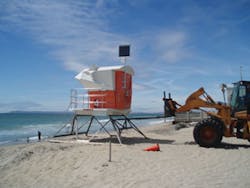Lifeguards at Imperial Beach in San Diego, Calif., were facing failing analog telephone lines and escalating lease line charges on their critical tower telecommunications system. In addition, they were hard-pressed to adequately monitor a 50-yard-long section of shoreline after a portable tower was removed from the area during an improvement project in 2009. That section of the beach, although vulnerable to dangerous riptides, draws a large crowd. The 'blind spot' that resulted for lifeguards when the tower was removed presented a safety concern as swimmers could easily go undetected on that stretch of beach and possibly overcome by the currents.
Installing a high-speed, wireless infrastructure to support VoIP communications and video backhauls provided a cost-effective, high-performance foundation for solving all of the issues. VoIP telephone links provided high-quality, secure voice communication between the dispatch supervisor and the individual lifeguards, eliminating lease line costs being incurred for the lifeguard towers every month as well as hundreds of man hours of annual line maintenance time. A high-definition, video camera for the area of the beach that was out of eye's view alleviated the safety concern and extended the ability of the lifeguards to fulfill their mission.
The dispatch tower is situated in the middle of the pier and looks back to the beach providing the lifeguards with a birds' eye view of all the swimmers in the water. This new method of dispatch allows them to communicate situations such as swimmers in riptide, riptides moving up and down the coast, stingray attacks and all types of events to perform their jobs effectively.
Sandy specification
Imperial Beach has six portable and two permanent lifeguard towers covering about one mile of beach. (The city's four full-time and 50 part-time lifeguards made 960 rescues in 2009.) Following a bidding and review process, the project was awarded and started in April 2010. The integrator selected for the project was TemeCom Inc., based in Temecula, Calif. TemeCom provides customized products and services focused on telecommunications, dispatch, wireless voice and monitoring applications.
Point to point/multi-point spec
TemeCom noted that the site lent itself to a wireless solution. "Everything is situated within a one- mile stretch of beach with an unobstructed line of sight," TemeCom co-founders Chris Smith and Kirk Williams said. "Making use of the southern California sun, the tower systems are 100 percent solar powered. The wireless system allows Imperial Beach to get rid of their old copper lines that were tethered to the towers. Now they have the flexibility to move the towers as required without having to trench and lay new cable," they added.
A major area of focus for TemeCom in the last four years has been Computer Aided Dispatch Systems for lifeguard and utility operations, resulting in successful installations for the California State Parks, Southern California Municipal Water District and San Diego Port Authority. Their flagship product-the wireless Lifeguard Telecommunications System (LTS)-combines a standards-based VoIP PBX server with wireless infrastructure replacement and their proprietary Lifeguard Dispatch Console to provide a low-maintenance, high-reliability solution in support of Lifeguard Operations.
The wireless system is a combination of point-to-multipoint and point-to-point networks. It provides the data stream for TemeCom's LTS with integrated VoIP, video and digital dispatch technology. The major equipment used on the project included the Fluidmesh 2200 Endo; Fluidmesh 2100 Endo; Fluidmesh 1100; FluidThrottle; an IP-based, high-definition PTZ camera; and the TemeCom LTS.
The wireless Lifeguard Tower Station at Imperial Beach was successfully activated and put into operation this past summer. This represents a major effort by TemeCom in conjunction with Fluidmesh to demonstrate the reliability, ease of maintenance and flexibility of a wireless infrastructure in an active Lifeguard Dispatch operation; the first of its kind on the West coast.
"Fluidmesh provided the optimum performance over price ratio with their selectable bandwidth option," Chris Smith and Kirk Williams concurred. "We could keep the per tower cost to a minimum by choosing a lower bandwidth for the VoIP communications and at the same time provide the high-speed video link and bridge backhaul where needed."
